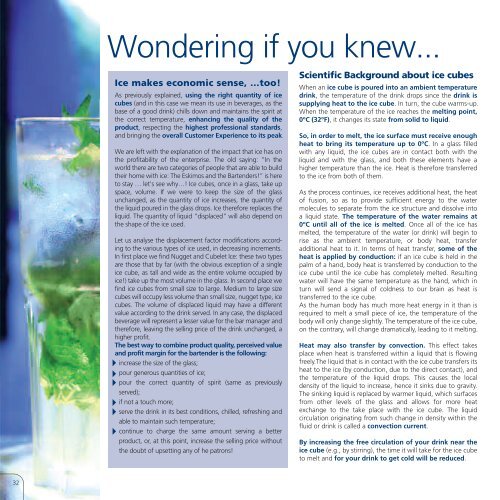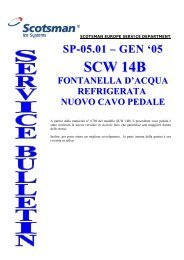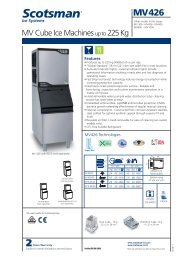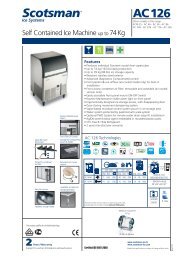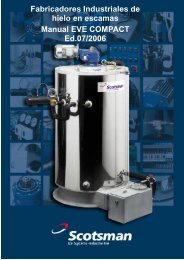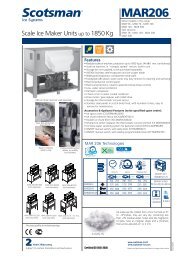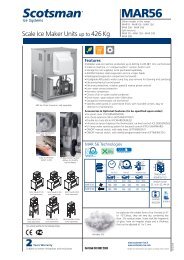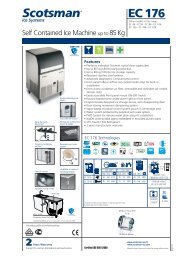You also want an ePaper? Increase the reach of your titles
YUMPU automatically turns print PDFs into web optimized ePapers that Google loves.
Wonder<strong>in</strong>g if you knew...<br />
Ice makes economic sense, …too!<br />
As previously expla<strong>in</strong>ed, us<strong>in</strong>g the right quantity of <strong>ice</strong><br />
cubes (and <strong>in</strong> this case we mean its use <strong>in</strong> beverages, as the<br />
base of a good dr<strong>in</strong>k) chills down and ma<strong>in</strong>ta<strong>in</strong>s the spirit at<br />
the correct temperature, enhanc<strong>in</strong>g the quality of the<br />
product, respect<strong>in</strong>g the highest professional standards,<br />
and br<strong>in</strong>g<strong>in</strong>g the overall Customer Experience to its peak.<br />
We are left with the explanation of the impact that <strong>ice</strong> has on<br />
the profitability of the enterprise. <strong>The</strong> old say<strong>in</strong>g: ”In the<br />
world there are two categories of people that are able to build<br />
their home with <strong>ice</strong>: <strong>The</strong> Eskimos and the Bartenders!” is here<br />
to stay … let's see why…! Ice cubes, once <strong>in</strong> a glass, take up<br />
space, volume. If we were to keep the size of the glass<br />
unchanged, as the quantity of <strong>ice</strong> <strong>in</strong>creases, the quantity of<br />
the liquid poured <strong>in</strong> the glass drops. Ice therefore replaces the<br />
liquid. <strong>The</strong> quantity of liquid "displaced" will also depend on<br />
the shape of the <strong>ice</strong> used.<br />
Let us analyse the displacement factor modifications accord<strong>in</strong>g<br />
to the various types of <strong>ice</strong> used, <strong>in</strong> decreas<strong>in</strong>g <strong>in</strong>crements.<br />
In first place we f<strong>in</strong>d Nugget and Cubelet Ice: these two types<br />
are those that by far (with the obvious exception of a s<strong>in</strong>gle<br />
<strong>ice</strong> cube, as tall and wide as the entire volume occupied by<br />
<strong>ice</strong>!) take up the most volume <strong>in</strong> the glass. In second place we<br />
f<strong>in</strong>d <strong>ice</strong> cubes from small size to large. Medium to large size<br />
cubes will occupy less volume than small size, nugget type, <strong>ice</strong><br />
cubes. <strong>The</strong> volume of displaced liquid may have a different<br />
value accord<strong>in</strong>g to the dr<strong>in</strong>k served. In any case, the displaced<br />
beverage will represent a lesser value for the bar manager and<br />
therefore, leav<strong>in</strong>g the sell<strong>in</strong>g pr<strong>ice</strong> of the dr<strong>in</strong>k unchanged, a<br />
higher profit.<br />
<strong>The</strong> best way to comb<strong>in</strong>e product quality, perceived value<br />
and profit marg<strong>in</strong> for the bartender is the follow<strong>in</strong>g:<br />
<strong>in</strong>crease the size of the glass;<br />
pour generous quantities of <strong>ice</strong>;<br />
pour the correct quantity of spirit (same as previously<br />
served);<br />
if not a touch more;<br />
serve the dr<strong>in</strong>k <strong>in</strong> its best conditions, chilled, refresh<strong>in</strong>g and<br />
able to ma<strong>in</strong>ta<strong>in</strong> such temperature;<br />
cont<strong>in</strong>ue to charge the same amount serv<strong>in</strong>g a better<br />
product, or, at this po<strong>in</strong>t, <strong>in</strong>crease the sell<strong>in</strong>g pr<strong>ice</strong> without<br />
the doubt of upsett<strong>in</strong>g any of he patrons!<br />
Scientific Background about <strong>ice</strong> cubes<br />
When an <strong>ice</strong> cube is poured <strong>in</strong>to an ambient temperature<br />
dr<strong>in</strong>k, the temperature of the dr<strong>in</strong>k drops s<strong>in</strong>ce the dr<strong>in</strong>k is<br />
supply<strong>in</strong>g heat to the <strong>ice</strong> cube. In turn, the cube warms-up.<br />
When the temperature of the <strong>ice</strong> reaches the melt<strong>in</strong>g po<strong>in</strong>t,<br />
0ºC (32ºF), it changes its state from solid to liquid.<br />
So, <strong>in</strong> order to melt, the <strong>ice</strong> surface must receive enough<br />
heat to br<strong>in</strong>g its temperature up to 0ºC. In a glass filled<br />
with any liquid, the <strong>ice</strong> cubes are <strong>in</strong> contact both with the<br />
liquid and with the glass, and both these elements have a<br />
higher temperature than the <strong>ice</strong>. Heat is therefore transferred<br />
to the <strong>ice</strong> from both of them.<br />
As the process cont<strong>in</strong>ues, <strong>ice</strong> receives additional heat, the heat<br />
of fusion, so as to provide sufficient energy to the water<br />
molecules to separate from the <strong>ice</strong> structure and dissolve <strong>in</strong>to<br />
a liquid state. <strong>The</strong> temperature of the water rema<strong>in</strong>s at<br />
0ºC until all of the <strong>ice</strong> is melted. Once all of the <strong>ice</strong> has<br />
melted, the temperature of the water (or dr<strong>in</strong>k) will beg<strong>in</strong> to<br />
rise as the ambient temperature, or body heat, transfer<br />
additional heat to it. In terms of heat transfer, some of the<br />
heat is applied by conduction: if an <strong>ice</strong> cube is held <strong>in</strong> the<br />
palm of a hand, body heat is transferred by conduction to the<br />
<strong>ice</strong> cube until the <strong>ice</strong> cube has completely melted. Result<strong>in</strong>g<br />
water will have the same temperature as the hand, which <strong>in</strong><br />
turn will send a signal of coldness to our bra<strong>in</strong> as heat is<br />
transferred to the <strong>ice</strong> cube.<br />
As the human body has much more heat energy <strong>in</strong> it than is<br />
required to melt a small piece of <strong>ice</strong>, the temperature of the<br />
body will only change slightly. <strong>The</strong> temperature of the <strong>ice</strong> cube,<br />
on the contrary, will change dramatically, lead<strong>in</strong>g to it melt<strong>in</strong>g.<br />
Heat may also transfer by convection. This effect takes<br />
place when heat is transferred with<strong>in</strong> a liquid that is flow<strong>in</strong>g<br />
freely.<strong>The</strong> liquid that is <strong>in</strong> contact with the <strong>ice</strong> cube transfers its<br />
heat to the <strong>ice</strong> (by conduction, due to the direct contact), and<br />
the temperature of the liquid drops. This causes the local<br />
density of the liquid to <strong>in</strong>crease, hence it s<strong>in</strong>ks due to gravity.<br />
<strong>The</strong> s<strong>in</strong>k<strong>in</strong>g liquid is replaced by warmer liquid, which surfaces<br />
from other levels of the glass and allows for more heat<br />
exchange to the take place with the <strong>ice</strong> cube. <strong>The</strong> liquid<br />
circulation orig<strong>in</strong>at<strong>in</strong>g from such change <strong>in</strong> density with<strong>in</strong> the<br />
fluid or dr<strong>in</strong>k is called a convection current.<br />
By <strong>in</strong>creas<strong>in</strong>g the free circulation of your dr<strong>in</strong>k near the<br />
<strong>ice</strong> cube (e.g., by stirr<strong>in</strong>g), the time it will take for the <strong>ice</strong> cube<br />
to melt and for your dr<strong>in</strong>k to get cold will be reduced.<br />
32


